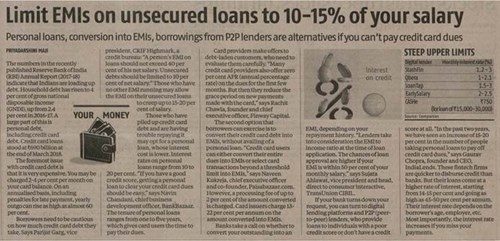Unsecured loans are costly; limit the EMIs to 10-15% of your salary
The numbers in the recently published Reserve Bank of India (RBI) Annual Report (2017-18) indicate that Indians are loading up debt. Household debt has risen to 4 percent of gross national disposable income (GNDI), up from 2.4 percent in 2016-17. A large part of this is personal debt, including credit card debt. Credit card loans stood at Rs 690 billion at the end of March 2018.
The foremost issue with credit card debt is that it is very expensive. You may be charged 2-4 percent per month on your card balance. On an annualised basis, including penalties for late payment, yearly outgo can rise as high as almost 60 percent.
Borrowers need to be cautious on how much credit card debt they take. Says Parijat Garg, vice president, CRIF Highmark, a credit bureau: “A person's EMI on loans should not exceed 40 percent of his net salary. Unsecured debts should be limited to 10 percent of net salary." Those who have no other EMI running may allow the EMI on their unsecured loans to creep up to 15-20 percent of salary.
Those who have piled up credit card debt and are having trouble repaying it may opt for a personal loan, whose interest cost is lower. Interest rates on personal loans range from 10 to 20 percent. “If you have a good credit score, getting a personal loan to clear your credit card dues should be easy," says Navin Chandani, chief business development officer, BankBazaar. The tenure of personal loans ranges from one to five years, which gives card users the time to pay their dues.
Card providers make offers to debt-laden customers, who need to evaluate them carefully. “Many credit card providers also offer zero percent APR (annual percentage rate) on the dues for the first few months. But then they reduce the grace period on new payments made with the card," says Rachit Chawla, founder and chief executive officer, Finway Capital.
The second option that borrowers can exercise is to convert their credit card debt into EMIs, without availing of a personal loan. “Credit card users can either convert their entire dues into EMIs or select card transactions beyond a threshold limit into EMIs," says Naveen Kukreja, chief executive officer and co-founder, Paisabazaar.com. However, a processing fee of up to 2 percent of the amount converted is charged. Card issuers charge 13-22 percent per annum on the amount converted into EMIs.
Banks take a call on whether to convert your outstanding into an EMI, depending on your repayment history. “Lenders take into consideration the EMI to income ratio at the time of loan application. The chances of loan approval are higher if your EMI is within 50 percent of your monthly salary," says Sujata Ahlawat, vice president and head, direct to consumer interactive, TransUnion CIBIL.
If your bank turns down your request, you can turn to digital lending platforms and P2P (peer-to-peer) lenders, who provide loans to individuals with a poor credit score or don't have a credit score at all.
"In the past two years, we have seen an increase of 15-20 percent in the number of people taking personal loans to pay off credit card dues," says Gaurav Chopra, founder, and CEO, IndiaLends. These fintech firms are quicker to disburse credit than banks. But their loans come at a higher rate of interest, starting at 14-15 percent and going as high as 45-50 percent per annum. Their interest rate depends on the borrower's age, employer, etc. Most importantly, the interest rate increases if you miss your payments.
Online Sources: Business Standard | Smart Investor
Print Source: Business Standard| Page No 02 |Edition: National

